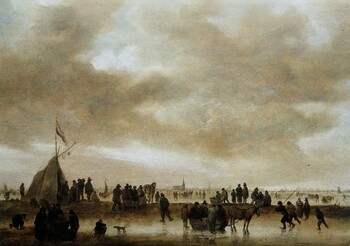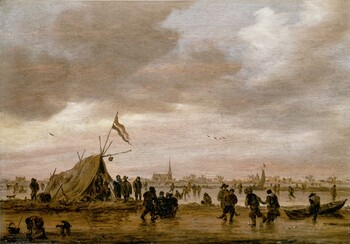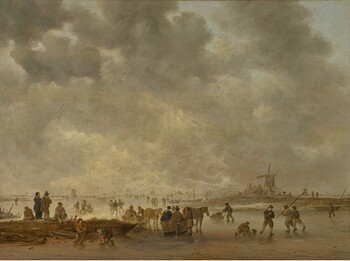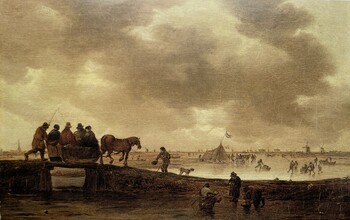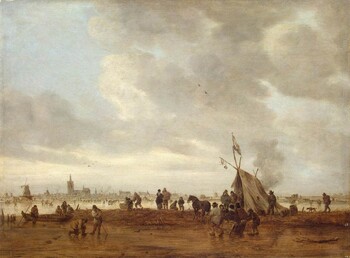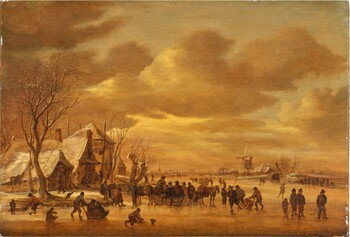9.400 €
Frozen river landscape with skaters and travellers in sledges
Oil on panel : 45,2 X 63,7 cm
Unsigned
Frame : 63,1 X 82,7 cm
Provenance : sold at Sotheby’s New York, 28/05/99
for 23.000 $ = 21.673 € as “follower of Jan van Goyen”
I am currently documenting this painting
In short
Jan van Goyen was between the late 1620s and the early 1640s the leading exponent of so-called tonal, monochrome landscape painting. He had dropped the traditional, colourful, narrative and idealized views of his early career, creating an innovative, atmospheric coherence in realistic, dynamic, grey-brown perspectives. Dozens of Dutch painters followed his example.
Our painter was influenced by van Goyen’s successive style, of the second half of the 1640s, when he incorporated some more colour in his scenery, before turning back to a restricted palette in the 1650s.
About Jan van Goyen
Dutch painter
Leiden 1596 -1656 The Hague
Prolific landscape painter of some 1.200 paintings and draughtsman of over 800 drawings.
Pupil of Esaias van de Velde in Haarlem.
Van Goyen started his career in the footsteps of Esaias van de Velde, painting in a traditional, anecdotic, Flemish-inspired, idealized style.
In 1627 he made a radical change, dropping the traditional landscape idiom. Under the influence of Pieter Molijn and of Pieter Dircksz. van Santvoort he painted realistic, naturalistic dune landscapes, seen from a low vantage point.
According to Houbraken, van Goyen moved to The Hague in 1631. He specialised here in simple river landscapes, painted in his characteristic, impressionistic, monochrome style with closely spaced colour gradations: sober, simple, but poetic depictions of his own direct observations. Following the death of his marine counterpart in tonal painting, Jan Porcellis (1632), van Goyen also took over this market.
In a loose, sketchy technique and with casual ease he rapidly produced inexpensive paintings, masterpieces made with just a few cheap pigments suggesting substance, texture, space and atmosphere. Some have called his evoloution towards extreme simplicity in composition and in colour a spiritual economy, others have stressed his financial motives.
Van Goyen was certainly obsessed with money: he invested in the housing market and circa 1637 in the tulip trade, which he became one of its most famous victims of. Influenced by Hercules Seghers van Goyen broaded his landscapes to panoramic views. By the end of the 1640s his colour palette became more colourful.
Next to his financial problems van Goyen had also artistic issues: his revolutionary pictorial innovations were so influential that he had numerous followers. Dozens of Dutch landscape painters adopted and copied his style and thus took over part of his market.
About our painting
Van Goyen painted during his entire career a limited number of winter landscapes.
He painted some at his start of his career unitl 1627: very decorative, lively, colourful Flemish-inspired works.
He again painted frozen landscapes during the first half of the 1640s: in his typical subdued tonalities he created an atmospheric unity.
He occasionally painted some more winter scenes until the end of his career in 1656.
There exists a second, similar composition of our frozen river landscape. It has some minor differences and its viewpoint is higher. It also bears a monogram “VG”. That painting was sold in March 1999 at Dorotheum Vienna as “attributed to Jan van Goyen”.
Hans-Ulrich Beck in the monograph about Jan van Goyen from 1972 considered the Dorotheum painting as by van Goyen, while he proposed that our painting was copied after that one. The insights about van Goyen have changed a lot in over 50 years, since 1972. Now that we have had our painting cleaned it has won a lot, but it would be too much of a stretch to assume that it might have been painted by van Goyen himself.
As to the Dorotheum painting I do not think it is by van Goyen either.
About koek-en-zopie
Merchants would set up shops on the ice. People could eat and drink in a typically Dutch “koek-en-zopie” tent. Such a tent is visible at the left side of our composition.
This term refers to the food and beverage that one could and still can buy while ice skating. “Koek” is a biscuit, a cookie. As to its best known drink, that was “zopie”; it was made of “bock”, which was a strong German lager, mingled with rum.
Why should you buy this painting?
Because our painter has created a realistic representation of a Dutch winter’s day: its dim, muted atmosphere is enlivened by some touches of colour.
Comparative paintings
Click photos for more details

